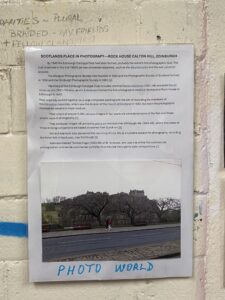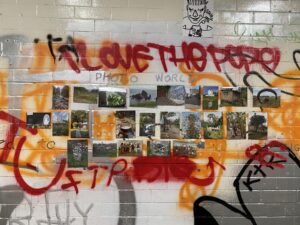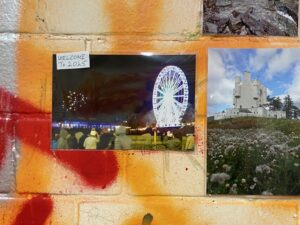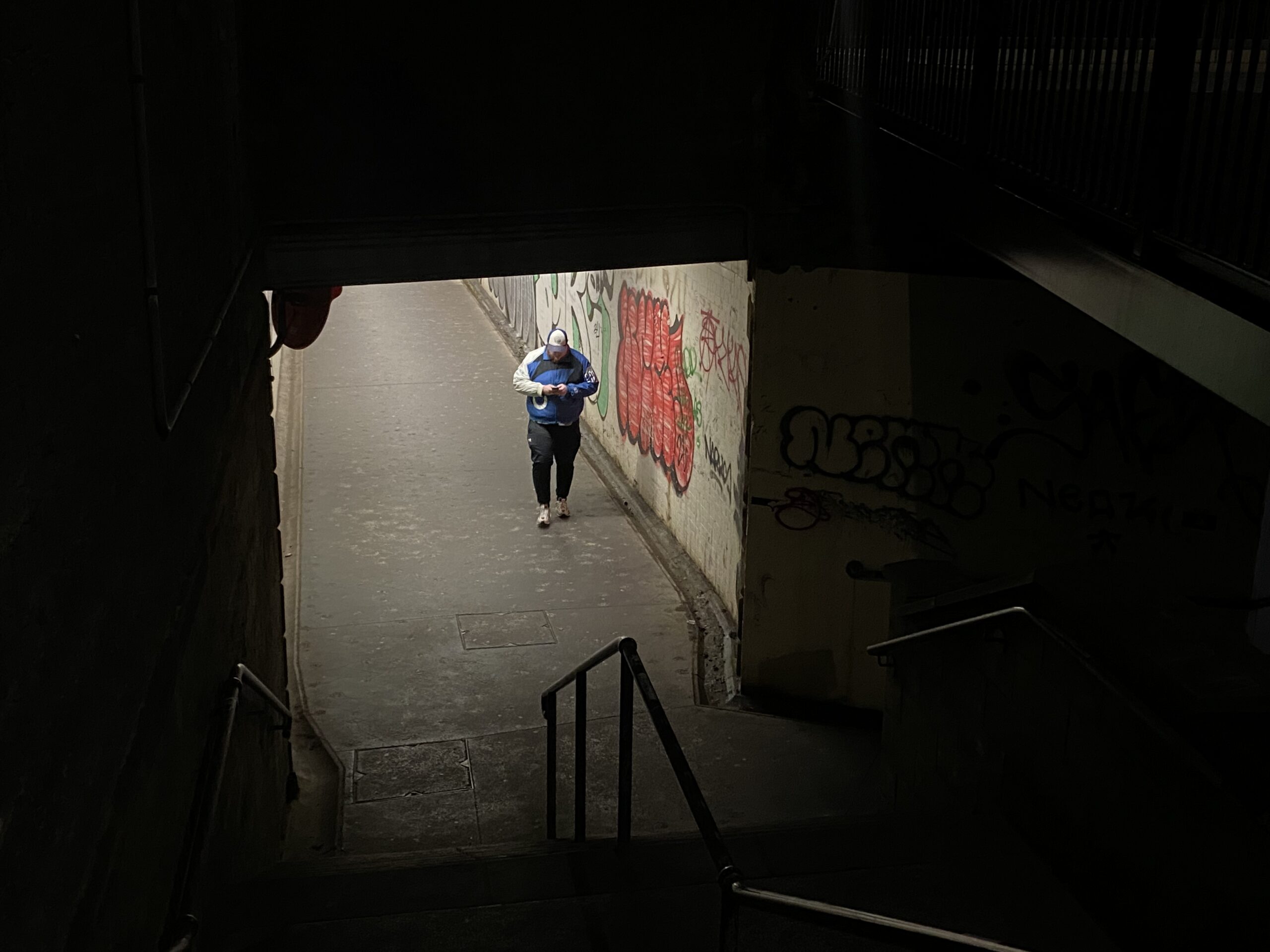🔝Week’s Focus
This week focused on Fran Cottell’s curatorial practice within her own home. By turning domestic space into an exhibition site, she disrupted the boundary between private and public. Her use of platforms, peepholes, and window-based viewing activated the audience’s role as both performer and observer. Cottell’s strategy of “slippage” challenged hierarchies between artist and viewer, visibility and invisibility, domesticity and display.
🙋🏻♀️Collective Planning Meeting
This week’s discussion focused on defining values and practices of collectivity. Using Miro, we mapped key principles like mutual respect, agency, interdisciplinary exchange, and equal contribution. We acknowledged the tension between individual autonomy and shared direction. I also presented my initial project idea—a tunnel-based exhibition exploring marginality and public memory—which received helpful feedback on curating in informal or “illicit” spaces.
🗺️SICP Venue Fieldnotes & Analysis
The History of Telfer Subway
The Telfer Subway is situated southeast of Fountain Park, connecting West Approach Road and Dundee Street.

Figure 1: Kim Traynor, Photograph of Telfer Subway, August 15, 2011. Available at: https://www.geograph.org.uk/photo/2559634.
According to Kim Traynor, the subway dates back to the mid-1840s when the Caledonian Railway Company built Dalry Station. Figure 1 shows the subway in 2011, with clean walls devoid of graffiti or artworks.

Figure 2: David Panton, Interior of Telfer Subway, April 27, 2018. Available at: https://www.railscot.co.uk/img/63/837/.
David Panton’s photograph, taken in 2018, reveals a bricked-up eastern entrance that once led to Dalry Road Station. This station was part of the Caledonian Railway line, which connected Edinburgh Princes Street Station to various destinations, including Granton, Leith North, Falkirk, and Aberdeen. The line was converted into a roadway in 1974, but remnants of its history, such as the blocked staircase, remain visible.
In 2018, the Telfer Subway was partially closed due to structural damage. An Edinburgh Evening News article reported that the City Council prioritized public safety and conducted urgent structural investigations on the damaged boundary wall. Pedestrians were redirected via an alternative route behind Lidl on Dalry Road during the repair period.
Source: https://www.edinburghnews.scotsman.com/news/telfer-subway-closed-for-urgent-wall-repairs-277360.

Figure 3: Richard Webb, Graffiti in Telfer Subway, May 7, 2023. Available at: https://www.geograph.org.uk/photo/7480745.
Telfer Subway’s Crime Issues
In 2011, Telfer Subway became a focal point of community safety concerns following violent incidents and antisocial behavior. Residents from Dalry and Fountainbridge petitioned for the installation of CCTV to address safety risks. The tunnel’s dark, enclosed environment, particularly at night, exacerbated the likelihood of criminal activities.
Source: https://theedinburghreporter.co.uk/2011/11/petition-plea-for-cctv-in-telfer-subway/?print=print.
Field Work in Telfer Subway
Before 2018, the walls of Telfer Subway were clean, but by 2023, as shown in Figure 3, graffiti had covered much of the white walls. Unlike the curated murals in places like Colinton Tunnel, the graffiti in Telfer Subway lacks a clear theme and features fragmented texts and images.
During my fieldwork, I discovered references to a photography group or individual called Photo World, which appeared in 2024. This group seems to present photographs of Scottish landscapes and local events, including an image of Edinburgh’s Christmas Market fireworks with the caption “WELCOME TO 2025” (Figure 8). Photo World also highlights Scotland’s photography history, mentioning calotype photography and notable Edinburgh-based photographers (Figure 6).
Despite my efforts, I could not find any online presence for Photo World. I plan to visit nearby shops and cafes to gather more information in the coming weeks.

Figure 6: Yiran Gu, Photo World’s Article – Scotland’s Place in Photography, January 30, 2025.

Figure 7: Yiran Gu, Photo World’s Photography Works, January 30, 2025.

Figure 8: Yiran Gu, Photo World’s Photography Works, January 30, 2025.

Figure 9. Yiran Gu, photograph of a bricked-up wall in Telfer Subway, showing visible marks of previous use, February 1, 2025.
Preliminary Curatorial Ideas
The exhibition will explore forgotten historical spaces, illegality, and marginality through various artistic mediums:
• Sound Installation: Record ambient noises, conversations, or footsteps in the subway to create an immersive experience.
• Video Projection: Project the image of a staircase onto the blocked eastern entrance, hinting at the tunnel’s historical connection to Dalry Road Station.
• Mixed Media: Combine video with sculptural installations, such as displaying footage on old televisions within a recreated tunnel scene.
• Light Intervention: Use light to emphasize different spatial layers in the dark tunnel.
• Interactive Audience Experience: Encourage visitors to navigate the space and reflect on its layered histories.
Challenges
• Theme Focus: How can I refine the exhibition’s focus into a more specific research question?
• Ethical Concerns: How to address the portrayal of homelessness and potential crime without compromising ethical considerations?
• Space Planning: How to design the exhibition layout without disrupting the subway’s functional use? Can Fran Cottell’s home exhibition layout inspire solutions?
Source: http://www.francottell.com/artwork/back-to-front.
• Spatial Depth: How to enrich the layered storytelling within the confined, rectangular space of the subway?
SICP:Preliminary Concept & Venue © 2025 by Yiran Gu is licensed under CC BY-NC-ND 4.0



6 February 2025 at 14:14
Your first post is very brief, therefore I cannot offer any feedback. However, your next posts are really detailed.
Your second blog post starts with the admission you do not currently have an idea for your speculative project. However, it outlines a clear plan of action, which is promising to see. You then go on to write very eloquently about your exhibition experience and describe the exhibition well. You can also relate it to other work and ideas, which shows great critical reflection. It was very interesting to read about the audiovisual content; this could be a great theme for an exhibition, so I would encourage you to reflect on what about this theory interests you as you may be able to relate this to your new idea. Your inclusion of images and quotes illustrates your reflections well.
Your third post outlines your initial idea for your speculative project. This idea is both achievable and realistic, and it is also very interesting. The interplay of site-specific places found objects like graffiti, and curated artworks such as photographs will create a rich and engaging experience. I recommend researching “Non-Spaces” by Marc Augé, as this could help you theorise about the transitory nature of an underground tunnel. It’s great to see you getting started with researching the site. Conducting a field study and learning about the history of the site will make you more informed and better equipped to address any ethical questions that may arise. Your preliminary curatorial ideas are clearly articulated, as is the outline of the challenges you might face. Further interrogation of these ideas will allow for more critical reflection and a stronger conceptual framework for your speculative project. You also use great documentation phototrophs to illustrate your initial research.